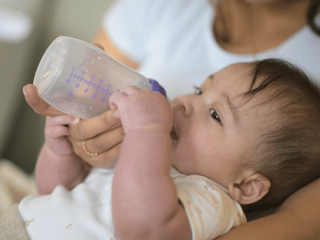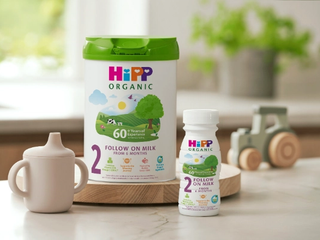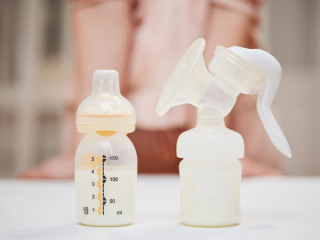
- Home
- Advice Hub
- Baby
- Baby Feeding
- Common Breastfeeding Problems
Breastfeeding problems
Struggling with breastfeeding? Learn about common issues, how to identify them, treatment options, ways to prevent them and when to seek support.
Overview of common breastfeeding problems
Breastfeeding problems are very common, especially during those first few weeks and months, as you and your baby are adjusting. Breastfeeding can be uncomfortable at first, but in some cases can cause some other conditions that can be painful and may need treatment.
This article shares some of the most common breastfeeding problems, how to identify them, next steps for treatment and helping prevent them from happening again. Remember to seek additional support from your healthcare professional, such as your midwife, breastfeeding support worker or GP if you have any concerns.
Sore or cracked nipples
If your nipples become sore, cracked or damaged, breastfeeding can be very painful. It’s important to try to do something about sore nipples as soon as you notice them, otherwise the problem might get worse. Some women are more prone to sore nipples than others, but the issue is often caused by issues with position and attachment. Ask your midwife, public health nurse, health visitor or a breastfeeding support worker to check your baby’s latch to see if they can see anything which could be making you sore. They may also want to check your baby for a tongue tie.
If your baby latches on and it doesn’t feel right or it feels uncomfortable, don’t just grit your teeth and carry on with the feed anyway. Take your baby off the nipple and try again. Make sure you break the latch first by sliding a clean finger into the side of your baby’s mouth and between their gums, so they open their mouth. It can feel frustrating when you have to reposition your baby, but it is worth the extra effort and will help prevent your nipples becoming sore.
Having cracked or damaged nipples increases your chance of developing thrush, an infection that can cause severe pain in your nipples, which may feel like a burning sensation. If you suspect you have thrush, see your GP as they can prescribe something to treat the infection.
Not enough breast milk
One of the most common concerns breastfeeding mothers have is that they aren’t producing enough milk for their baby. Breastfeeding works on a supply and demand basis, so the more you feed your little one, the more milk your body will produce.
Always ensure your baby has emptied one breast before feeding on the other. That way each breast gets properly emptied. Alternate which breast you offer first – you might want to wear a bracelet or something on your wrist to remind you of which side to start with next.
Skin to skin cuddles with your baby can help stimulate milk supply. You could also express in between feeds to boost your milk production.
Make sure you are eating well and drinking plenty of fluids. You don’t need to eat anything special when you’re breastfeeding, but it is a good idea to make sure you’re eating a range of healthy foods and getting all the nutrients you need to keep your energy up. Tread carefully when it comes to foods or recipes that claim to increase your milk supply. These claims are largely unproven.
A good latch can also lead to a good milk supply, so if you are having any problems this is another reason to get support with positioning and attachment as early as possible.
Too much breast milk
Sometimes the problem is too much milk. Over production can occur in the early days as the supply gets going, or if baby is not latching on to drain the breast well. If you feel like you might be experiencing oversupply, speak to your midwife, public health nurse, health visitor or a breastfeeding specialist for advice.
It is normal for your breasts to leak while your milk supply is becoming established, so this alone isn’t a sign that you are producing too much milk. However, if your baby seems to be finding it difficult to cope with the flow of milk and is coughing or spluttering or coming off the breast in surprise, oversupply might be an issue.
Try laid back breastfeeding as this will allow your baby to have more control over the flow of milk. Feed while lying down or in a reclined position with your baby on your chest. Find out more information about breastfeeding positions in our guide.
Breast engorgement
If your breasts are very full, it can be very uncomfortable and they may feel hard and tight – almost as if you have rocks inside them. You may experience engorgement in the early days of breastfeeding when your baby is learning to feed and may not be taking large amounts of milk. Engorged breasts can also happen when you reduce how often you breastfeed.
If your breasts feel engorged, massage them gently to help get your milk flowing. Try to feed as much as you can and if your baby can’t keep up with your supply, you may want to express some milk until your breasts feel less firm and full.
Placing a warm wet cloth on your breasts for a couple of minutes before feeding can help relieve discomfort and get your milk flowing. After a feed, you could apply a cold compress or gel pads to help reduce the swelling.
Baby is not latching on properly
Worried about your baby not latching properly? Remember that breastfeeding is a skill that both you and your baby need to learn, so it can take a little while to get the hang of it. If your baby isn’t latching on properly, breastfeeding can be uncomfortable and your baby might not be getting enough milk. Ask your midwife, public health nurse or health visitor to watch you breastfeed and check your latch.
You can also seek help from breastfeeding specialists and look for breastfeeding groups in your local area where parents can go for advice and support. Often, issues with latch can be resolved by making a few changes. We also have an article with top tips to getting the latch right, you can read it here.
Breastfeeding and thrush
Breast and nipple pain can sometimes be caused by a thrush infection in the breast, known as candida. This can also affect breastfed babies by developing in their mouths. Thrush infections can occur when nipples become cracked or damaged, allowing the thrush infection to enter the nipple or breast. Thrush can also be more common after a course of antibiotics.
Signs of thrush include the sudden onset of nipple or breast pain after feeding. Pain associated with thrush can range from mild to severe and lasts up to an hour after each feed. In breastfed babies, symptoms of oral thrush include creamy white spots or patches on the tongue, gums, roof of the mouth, or inside the cheeks that do not wipe off easily, a white film on the lips, being unsettled during feeds, and, in some cases, persistent nappy rash.
If these symptoms are present, it is important to speak with your healthcare professional, who may take swabs from the nipples and the baby's mouth to confirm the infection. If either you or your baby does have thrush, you'll need to be treated at the same time as the infection can spread between you.
Blocked milk duct
If you can feel small lumps in your breast that feel sore and tender, you may have a blocked milk duct. These can happen when your breasts become engorged and are not emptied at each feed. If these lumps don’t reduce with feeding and are accompanied by pain, swelling and/or a fever, it could be mastitis, which is described below.
Mastitis
Mastitis is common when breastfeeding and is when the breast becomes swollen, hot, and painful. Mastitis often affects only one breast, with symptoms appearing quite suddenly.
Symptoms include having a swollen area on the breast that may feel hot and sore, or may have some redness. Some women experience a lump or hard area when they have mastitis. Many women experience a burning pain in the breast, either all the time or when breastfeeding. Sometimes the nipple may have some white or blood coloured discharge. Mastitis can also cause symptoms such as body aches, a high temperature, chills, and fatigue.
Mastitis is usually treated at home, but you should contact your GP if symptoms do not improve after 24 hours. You can help soothe mastitis by continuing to breastfeed as usual. You may want to try using a warm cloth which can help improve milk flow. Additionally, using a cool cloth can help soothe discomfort and it’s important to stay well hydrated and take as much rest as you can. If you keep getting mastitis, checking your feeding positions with your midwife, public health nurse or health care professional is advised.
Breast abscess
A breast abscess can develop when there is an infection and buildup of pus in the breast. Symptoms include a lump or swelling in the breast, it might be painful, have some redness and feel warm. Additionally, you might experience a high temperature or a general feeling of being unwell. Breast abscesses are more common if you have recently had a breast infection such as mastitis or experienced a breast abscess before. While not usually serious, an abscess does need to be reviewed in hospital, and an ultrasound can confirm if there is an abscess. In some cases, the abscess may need to be drained, which is done with a local anesthetic and usually heals in a few days alongside a course of antibiotics.
Breastfeeding and tongue tie
Tongue ties in babies can make breastfeeding more challenging by preventing a baby from latching on properly. It can also potentially cause sore or cracked nipples. A tongue-tie is caused by a little strip of tissue underneath the tongue (called the frenulum) being shorter than usual. Some tongue-ties can be serious and some very mild, making it hard to spot in some babies.
Signs of a tongue-tie include limited tongue movement, a heart-shaped tongue when sticking it out, or difficulty extending the tongue. Babies with tongue-tie may struggle to latch, may nurse for long periods and take frequent breaks. Additionally, they may seem constantly hungry, have difficulty gaining weight, or make a clicking sound while feeding.
However, some babies with tongue-tie have no feeding difficulties and may not require treatment. Midwives check for tongue-tie during the first routine examination, but it is not always noticeable and may be identified later if there are issues with breastfeeding. A tongue-tie can cause mums to experience issues such as low milk supply, sore or cracked nipples or engorged breasts.
If the tongue-tie needs to be treated, your baby can have a procedure called a frenulotomy. This is carried out by a specially trained doctor, nurse or midwife and takes just a few seconds. The health care professional will cut the tight piece of skin connecting the underside of the tongue to the floor of the mouth, and usually no anaesthetic is used. As soon as it's done, you can feed your baby, which helps to heal any bleeding.
Causes and solutions for nipple pain and soreness
When starting breastfeeding, some nipple pain and soreness is expected as your body adjusts and you and your baby master a new skill. It is really important that you continue feeding even when your nipples are sore. If you stop feeding, this will have a negative impact on your milk supply and your breasts can become painful and engorged. If your nipples are already painful, use a nipple cream or balm before and after feeding. A cream that contains pure lanolin is particularly effective and won’t need to be removed before feeding.
Rubbing a little bit of breastmilk into damaged nipples can also soothe them and help them to heal quickly. Make sure you let your nipples dry completely after each feed and change your breast pads regularly.
If feeding feels painful or uncomfortable, don’t push through the pain. Gently take your baby off, and try again. To break the latch, slide a clean finger into the side of their mouth and between their gums until they open their mouth. Repositioning can be frustrating, but it helps prevent sore nipples and makes feeding more comfortable. Ask your midwife, public health nurse, health visitor, or breastfeeding support worker to check your baby’s latch to see if anything is causing discomfort. They may also check for a tongue-tie.
Addressing low milk supply and feeding frequency concerns
Worrying about milk supply is very common when starting to breastfeed. If your baby is producing wet nappies, is settled after they feed and is gaining weight, it is likely that your milk supply is just right for your baby.
You can find out more about concerns about milk supply in this article .
Additionally, speak to your health care professional such as your midwife or breastfeeding support worker to discuss any concerns.
Your baby’s feeding pattern will change as they develop and grow, which can be unsettling, especially if you think they’re feeding very often and might not be getting enough milk. This might be an indication that your baby is cluster feeding, which is when your baby feeds more frequently than usual.
Managing engorgement, mastitis, and blocked ducts
Breast engorgement, blocked ducts and mastitis can all cause discomfort and affect milk flow. Understanding how to manage these conditions can help relieve discomfort and improve your experience with breastfeeding.
Importantly, is to continue breastfeeding frequently to keep milk flowing and prevent further build-up. If your baby is struggling to latch due to breast engorgement, you can try to manually express or pump milk to help soften the breast. Applying warm compresses before feeding can encourage milk flow and gently massaging towards the nipple during feeds can help clear blocked ducts. Changing feeding positions may also help drain different areas of the breast effectively, with an article available all about different feeding positions. After feeding, cold packs can reduce swelling and discomfort, and wearing a non-restrictive bra can help.
Finally, is the importance of staying hydrated and well-rested with pain relief, such as ibuprofen or paracetamol, if you need something to help ease discomfort. If symptoms of mastitis do not improve and you are experiencing persistent pain, fever, or flu-like symptoms, it is important to seek medical advice from your health care professional.
Tips for overcoming breastfeeding challenges
Breastfeeding can be challenging but is a rewarding way for you and your baby to get to know each other. You may need a little help getting started, especially if it’s your first time breastfeeding. Be patient with yourself and make use of the support available to make the journey easier. Joining peer support groups, whether online or in person, can be helpful. Speak to your healthcare professional about available support, such as breastfeeding support workers or positioning help from your midwife. Don't go through it alone, support is there to help.












